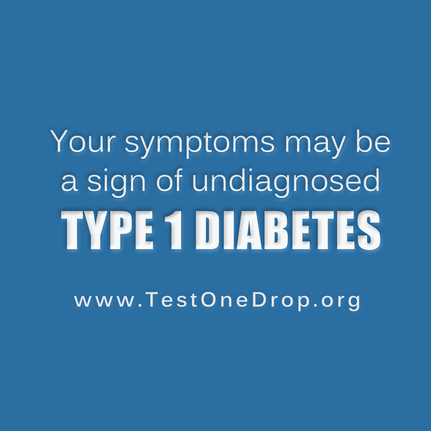Diabetic ketoacidosis is a life-threatening condition which often develops quickly when the signs and symptoms of Type 1 diabetes have been overlooked or mistaken for other illnesses. A simple glucose test can detect early onset Type 1 diabetes and stop diabetic ketoacidosis before it kills!
TEST ONE DROP
TO STOP
DIABETIC KETOACIDOSIS
Progressing symptoms of undiagnosed Type 1 diabetes often imitate COVID-19, flu, strep, stomach virus, urinary tract infections, growth spurts and other common illnesses. When left untreated, Type 1 diabetes can develop into a life-threatening complication called diabetic ketoacidosis (DKA). If you or a loved one have a combination of the following symptoms, immediately request medical personnel Test One Drop of blood or urine for glucose (sugar) and ketone levels. A simple, inexpensive glucose test–performed in seconds–can save lives.
Important notes: DKA can be present without high blood sugar, so always ask for ketone testing, as well. If DKA is present, it's IMPERATIVE medical personnel use proper DKA protocol to re-balance one's body chemistry to prevent other life-threatening complications.
Important notes: DKA can be present without high blood sugar, so always ask for ketone testing, as well. If DKA is present, it's IMPERATIVE medical personnel use proper DKA protocol to re-balance one's body chemistry to prevent other life-threatening complications.
|
These symptoms can be an indication of Type 1 diabetes. They are listed in possible order of progression, but your experience may vary.
*A combination of these symptoms can be life-threatening and indicates possible DKA has developed. Seek emergency medical care immediately.
|
PLEASE NOTE:
UNDIAGNOSED AND UNTREATED TYPE 1 DIABETES AND DIABETIC KETOACIDOSIS ARE 100% FATAL! Seek EMERGENCY CARE anytime you have a combination of these symptoms:
NAUSEA, VOMITING, LETHARGY, FATIGUE, SHORTNESS OF BREATH, LABORED BREATHING, CONFUSION, OR UNCONSCIOUSNESS
Insist medical personnel Test One Drop of blood or urine to screen glucose and ketone levels.
|
Anyone of any age, race, family medical history, socio-economic level, body type, general health condition, life-style, etc. can be diagnosed with an autoimmune disease called Type 1 diabetes.
Despite the fact that it is also known as "juvenile diabetes", Type 1 diabetes is diagnosed in people of all ages, both children and adults. In fact, according to the U.S. Centers for Disease Control and Prevention (CDC), more than one-half of all new Type 1 diabetes diagnoses are adults over the age of 20, many of whom are first mistakenly diagnosed with a metabolic disorder called Type 2 diabetes.** Additionally, a 2019 study showed 38% of people with Type 1 diabetes who were diagnosed over the age of 30 were initially diagnosed with Type 2 diabetes, causing life-threatening delays in insulin treatment.***
Small children younger than six years old are at increased risk of developing the complication diabetic ketoacidosis (DKA) before diagnosis of Type 1 diabetes due to multiple factors, such as: communication challenges, knowledge about symptoms in parents and providers, availability of care, changes in insurance programs and coverage policies, and delayed entry to medical facilities.****
Even though new onset Type 1 diabetes develops over different periods of time for different people, e.g., weeks, months, years, the life-threatening complication called DKA can occur suddenly if Type 1 diabetes is left undiagnosed and untreated . . . with devastating consequences. While most who suffer from life-threatening DKA at Type 1 diabetes onset recover with hospitalization and proper DKA treatment and are able to manage their disease with insulin and live active lives, many are permanently disabled (traumatic brain injuries, limb loss) or die because their symptoms and complications progressed too far before diagnosis.
Our mission at Test One Drop is to bring awareness about diabetic ketoacidosis (DKA) to the general public and medical communities so no more children or adults suffer disability or death as a result of delayed or missed diagnosis of Type 1 diabetes. We envision glucose and ketone testing becoming routine anytime the symptoms listed above are present at sick-care visits.
Finally, some physicians, pediatricians, and other medical care providers who recognize the dangers of missing a diagnosis take a proactive approach and routinely Test One Drop of blood or urine at well-care checkups to screen for signs of elevated glucose or ketone levels. Because symptoms of new onset Type 1 diabetes can be subtle and unrecognizable, if your doctor doesn't routinely test and you've noticed some of the early warning signs of Type 1 diabetes, as listed above–even though the patient does not seem extremely ill–please report the symptoms to your medical health care provider and ask to be tested. A few seconds of time plus a simple, inexpensive test could catch elevated blood glucose or ketone levels BEFORE more serious symptoms occur and life-threatening DKA develops.
Despite the fact that it is also known as "juvenile diabetes", Type 1 diabetes is diagnosed in people of all ages, both children and adults. In fact, according to the U.S. Centers for Disease Control and Prevention (CDC), more than one-half of all new Type 1 diabetes diagnoses are adults over the age of 20, many of whom are first mistakenly diagnosed with a metabolic disorder called Type 2 diabetes.** Additionally, a 2019 study showed 38% of people with Type 1 diabetes who were diagnosed over the age of 30 were initially diagnosed with Type 2 diabetes, causing life-threatening delays in insulin treatment.***
Small children younger than six years old are at increased risk of developing the complication diabetic ketoacidosis (DKA) before diagnosis of Type 1 diabetes due to multiple factors, such as: communication challenges, knowledge about symptoms in parents and providers, availability of care, changes in insurance programs and coverage policies, and delayed entry to medical facilities.****
Even though new onset Type 1 diabetes develops over different periods of time for different people, e.g., weeks, months, years, the life-threatening complication called DKA can occur suddenly if Type 1 diabetes is left undiagnosed and untreated . . . with devastating consequences. While most who suffer from life-threatening DKA at Type 1 diabetes onset recover with hospitalization and proper DKA treatment and are able to manage their disease with insulin and live active lives, many are permanently disabled (traumatic brain injuries, limb loss) or die because their symptoms and complications progressed too far before diagnosis.
Our mission at Test One Drop is to bring awareness about diabetic ketoacidosis (DKA) to the general public and medical communities so no more children or adults suffer disability or death as a result of delayed or missed diagnosis of Type 1 diabetes. We envision glucose and ketone testing becoming routine anytime the symptoms listed above are present at sick-care visits.
Finally, some physicians, pediatricians, and other medical care providers who recognize the dangers of missing a diagnosis take a proactive approach and routinely Test One Drop of blood or urine at well-care checkups to screen for signs of elevated glucose or ketone levels. Because symptoms of new onset Type 1 diabetes can be subtle and unrecognizable, if your doctor doesn't routinely test and you've noticed some of the early warning signs of Type 1 diabetes, as listed above–even though the patient does not seem extremely ill–please report the symptoms to your medical health care provider and ask to be tested. A few seconds of time plus a simple, inexpensive test could catch elevated blood glucose or ketone levels BEFORE more serious symptoms occur and life-threatening DKA develops.
**According to the National Institutes of Health (NIH), as many as 10% of those who are diagnosed with Type 2 diabetes may actually have Type 1 diabetes. Type 2 diabetes is a metabolic disorder and is also known as "non insulin-dependent diabetes mellitus" (NIDDM), therefore people who are diagnosed with Type 2 are not usually started on insulin therapy. Without insulin treatment, a large number of the people who are mistakenly diagnosed as having Type 2 diabetes later go into DKA. Although this mostly occurs in adults over the age of 40, it can happen to anyone–even children. If you or your loved one (adult or child) is diagnosed with Type 2 diabetes, request your medical health care provider obtain an autoantibody test to officially distinguish between the two types and assure a proper diagnosis and proper treatment.
***According to the National Institutes of Health (NIH), 38% of patients with Type 1 diabetes occurring after age 30 were initially treated as Type 2 diabetes (without insulin). Therefore, they need a C-peptide test to confirm what type of diabetes they have. Conclusion: Type 1 diabetes diagnosed over 30 years of age, defined by severe insulin deficiency, has similar clinical and biological characteristics to that occurring at younger ages, but is frequently not identified. Clinicians should be aware that patients progressing to insulin within 3 years of diagnosis have a likelihood of Type 1 diabetes, regardless of initial diagnosis.
****In the the U.S., 208,000 people under the age of 20 had Type 1 diabetes in 2012. Type 1 is currently increasing at a rate of 23%. (NDEP, CDC, NIH) According to Diabetes Care, Volume 34, November 2011, the reported prevalence of DKA in children, in 2011, was:
<5 years of age 17.3 - 54%
<3 years of age 39.7%
<2 years of age 60%.
These statistics are considered to be low, as they are five years old, and will be updated as more accurate information is discovered.
***According to the National Institutes of Health (NIH), 38% of patients with Type 1 diabetes occurring after age 30 were initially treated as Type 2 diabetes (without insulin). Therefore, they need a C-peptide test to confirm what type of diabetes they have. Conclusion: Type 1 diabetes diagnosed over 30 years of age, defined by severe insulin deficiency, has similar clinical and biological characteristics to that occurring at younger ages, but is frequently not identified. Clinicians should be aware that patients progressing to insulin within 3 years of diagnosis have a likelihood of Type 1 diabetes, regardless of initial diagnosis.
****In the the U.S., 208,000 people under the age of 20 had Type 1 diabetes in 2012. Type 1 is currently increasing at a rate of 23%. (NDEP, CDC, NIH) According to Diabetes Care, Volume 34, November 2011, the reported prevalence of DKA in children, in 2011, was:
<5 years of age 17.3 - 54%
<3 years of age 39.7%
<2 years of age 60%.
These statistics are considered to be low, as they are five years old, and will be updated as more accurate information is discovered.

